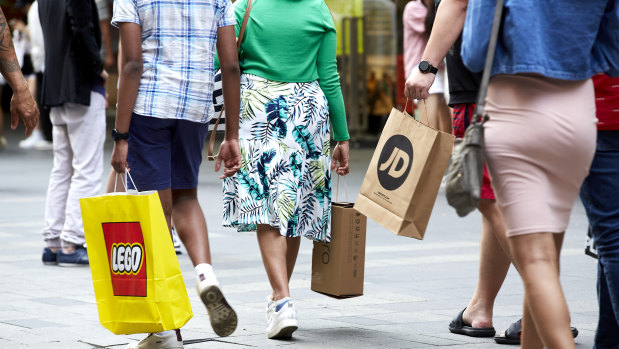Shoppers turn away from household goods but overall spending surges
Australian households spent more across every consumer category except household goods in the 12 months to November, in the latest indication that retailers focused on furniture and appliances find themselves in a tough spot ahead of a broader spending slowdown.
The Australian Bureau of Statistics’ monthly household spending indicator, released on Tuesday, showed spending jumped 11.4 per cent in the year to November 2022, a less significant rise than in previous months. However, spending on furnishings and household equipment declined by 7 per cent.

Clothing and footwear spending rose by 2.4 per cent, but this rate of growth was smaller than in previous months. Spending on clothes among households in NSW declined by 1.6 per cent, while it was flat in Victoria.
Categories where spending rose also included food, alcohol, health, transport, recreation, hotels, cafes and restaurants.
The ABS said in a statement that the decline in furnishings spending resulted from a comparison with data from November 2021, when there was “strong post-lockdown spending in this category”.
But the figures give yet another hint that discretionary retailers and those in the home-improvement space will be unable to maintain the momentum built over two years of pandemic shopping, particularly if interest rates continue to rise.
Post-Christmas sales forecasts from the Australian Retailers Association and Roy Morgan tip that all sectors will experience spending gains in the three weeks to January 15, but household goods sales will have some of the smallest gains with an increase of 3.7 per cent on last year.
Meanwhile, inflation was sitting at 6.9 per cent in the 12 months to October.
A range of home-goods retailers including Harvey Norman, Temple & Webster and Kogan.com have been upbeat in the lead-up to Christmas about consumers’ appetite to continue spending.
But analysts who watch discretionary retail and the home goods sector in particular are expecting evidence of a slowdown to hit after companies report their next half-year earnings in February.
Morgan Stanley’s team says the unwind in consumer spending could be worse than expected, because the pandemic has pulled forward demand across a range of sectors, which boosted spending during the lockdown era.
“As the consumer looks at ways to reduce spend, we see downside risk to CY23 discretionary category sales expectations,” its analysts said in a note to clients.
The retail industry group is also preparing for conditions to slow, with Australian Retailers Association boss Paul Zahra reflecting last December that rising costs are likely to eventually impact how much consumers can spend.
“Moving into next year, we do expect things to slow down – with a lag effect likely to the impact of inflation on retail spending,” he said last month.
The Business Briefing newsletter delivers major stories, exclusive coverage and expert opinion. Sign up to get it every weekday morning.
Most Viewed in Business
Source: Thanks smh.com